Little Lily Baby Blanket
19.Apr.21 / Kirsten BalleringThe Little Lily Baby blanket, much like its big sister Noelle, is a must-have blanket! This stunning project is designed to work with a Scheepjes Catona Colour Pack, which allows you to create a colourful blanket without going through the hassle of collecting all the colours separately. The rainbow goodness together with the crisp white border makes this is a blanket that you're not likely to forget!
Materials and preparation
Yarn
- Colour A: 106 Snow White x 3 balls
- Full pack: x 109 balls
Shop the yarn
You can find Scheepjes Colour packs at Scheepjes retailers such as:
Crochet hook
3.5mm (US Size E/4).
Measurements
Blocked and finished blanket measures 91 x 115cm (36 x 45in).
Gauge/tension
Motif up to Round 5 measures 7cm (2.75in) across flat to flat side, 8cm (3.15in) across point to point.
Notes
- You’ll use different colours for each motif. These are indicated in the pattern as ‘Colour 1’ and ‘Colour 2’. Check out the colour layout and table for the actual colour combinations. Please note that full motifs with combination 52 and 88 are only made once, all the other twice.
- The motifs are joined together in Round 5 as-you-go.
Abbreviations (US terms)
- BPhdc: Back Post half double crochet: yarn over, insert hook from back to front and back to back around stem of st, yarn over, pull up loop, yarn over, pull through all loops
- ch: chain
- ch-sp: chain-space
- dc: double crochet
- dc2tog: double crochet 2 stitches together: (yarn over, insert hook in st/sp, yarn over, pull up loop, yarn over, pull through first 2 loops on hook ) in each of the two sts/sps, yarn over, pull through all loops on hook
- dc3tog: double crochet 3 stitches together: (yarn over, insert hook in st/sp, yarn over, pull up loop, yarn over, pull through first 2 loops on hook ) in each of the three sts/sps, yarn over, pull through all loops on hook
- dc5tog: double crochet 5 stitches together: (yarn over, insert hook in st/sp, yarn over, pull up loop, yarn over, pull through first 2 loops on hook ) in each of the five sts/sps, yarn over, pull through all loops on hook
- dropped hdc: dropped half double crochet: yarn over, insert hook in indicated st/sp, yarn over, pull up loop, yarn over, pull through all loops on hook
- hdc: half double crochet
- picot: ch2, insert hook in second ch from hook, yarn over, pull up loop and immediately pull through loops on hook
- RS: right side
- sc: single crochet
- sp(s): space(s)
- ss: slip stitch
- st(s): stitch(es)
- WS: wrong side
Repeat formats
- *….; rep from * once/twice/3x Crochet the instructions after * and then repeat that section a further number of times as indicated.
- (…) once/twice/3x Crochet the instructions between brackets the total number of times indicated.
- […] Indicates the amount of stitches at the end of a row or round.
- (…) in same st/sp Indicates that all instructions between brackets are worked in the same stitch or space.
Colour layout
Full motif colour combinations
You will create 182 full motifs and 13 half motifs with the colours from your colour pack. You’ll need to make two full motifs out of each colour combination, with the exception of combination 88 and 52 where you’ll only make one full motif.
Note that the colour combinations are paired: Combination 1 and 2 are both combining the same colours, only for two motifs Colour 1 is used on the inside, and for the other combination Colour 2. So while the table lists 92 combinations, you only have 46 pairs of colours. The numbers in the table below correspond with the numbers in the colour overview.
You will not use colour 74, 105, 106, 110, 130, 157, 162, 248, 254, 257, 387, 393, 395, 404, 501, 505 and 507.
Tip: Sort out your combinations at the start of the blanket and keep the balls together with a rubber band or something similar.
Combination |
Colour 1 (inside) |
Colour 2 (outside) |
1 |
524 |
263 |
2 |
263 |
524 |
3 |
264 |
256 |
4 |
256 |
264 |
5 |
396 |
517 |
6 |
517 |
396 |
7 |
516 |
115 |
8 |
115 |
516 |
9 |
281 |
386 |
10 |
386 |
281 |
11 |
258 |
192 |
12 |
192 |
258 |
13 |
255 |
414 |
14 |
414 |
255 |
15 |
410 |
189 |
16 |
189 |
410 |
17 |
252 |
390 |
18 |
390 |
252 |
19 |
388 |
504 |
20 |
504 |
388 |
21 |
522 |
249 |
22 |
249 |
522 |
23 |
101 |
179 |
24 |
179 |
101 |
25 |
403 |
100 |
26 |
100 |
403 |
27 |
208 |
280 |
28 |
280 |
208 |
29 |
411 |
383 |
30 |
383 |
411 |
31 |
528 |
244 |
32 |
244 |
528 |
33 |
212 |
525 |
34 |
525 |
212 |
35 |
261 |
124 |
36 |
124 |
261 |
37 |
245 |
205 |
38 |
205 |
245 |
39 |
513 |
515 |
40 |
515 |
513 |
41 |
253 |
241 |
42 |
241 |
253 |
43 |
512 |
392 |
44 |
392 |
512 |
45 |
389 |
412 |
46 |
412 |
389 |
47 |
385 |
514 |
48 |
514 |
385 |
49 |
402 |
391 |
50 |
391 |
402 |
51 |
172 |
242 |
52 (only 1) |
242 |
172 |
53 |
400 |
146 |
54 |
146 |
400 |
55 |
509 |
510 |
56 |
510 |
509 |
57 |
397 |
401 |
58 |
401 |
397 |
59 |
247 |
399 |
60 |
399 |
247 |
61 |
511 |
201 |
62 |
201 |
511 |
63 |
384 |
173 |
64 |
173 |
384 |
65 |
527 |
164 |
66 |
164 |
527 |
67 |
113 |
508 |
68 |
508 |
113 |
69 |
520 |
521 |
70 |
521 |
520 |
71 |
240 |
526 |
72 |
526 |
240 |
73 |
398 |
128 |
74 |
128 |
398 |
75 |
251 |
394 |
76 |
394 |
251 |
77 |
226 |
282 |
78 |
282 |
226 |
79 |
246 |
519 |
80 |
519 |
246 |
81 |
409 |
413 |
82 |
413 |
409 |
83 |
518 |
114 |
84 |
114 |
518 |
85 |
238 |
222 |
86 |
222 |
238 |
87 |
408 |
523 |
88 (only 1) |
523 |
408 |
89 |
502 |
503 |
90 |
503 |
502 |
91 |
406 |
506 |
92 |
506 |
406 |
Half motif colour combinations
Make 1 half motif each with combination 19, 21, 23, 26, 28, 30, 34, 37, 41, 44, 50, 52 and 90. If you don’t have enough yarn leftovers for these combinations, pick similar colours that are not used in adjacent motifs.
Colour Layout
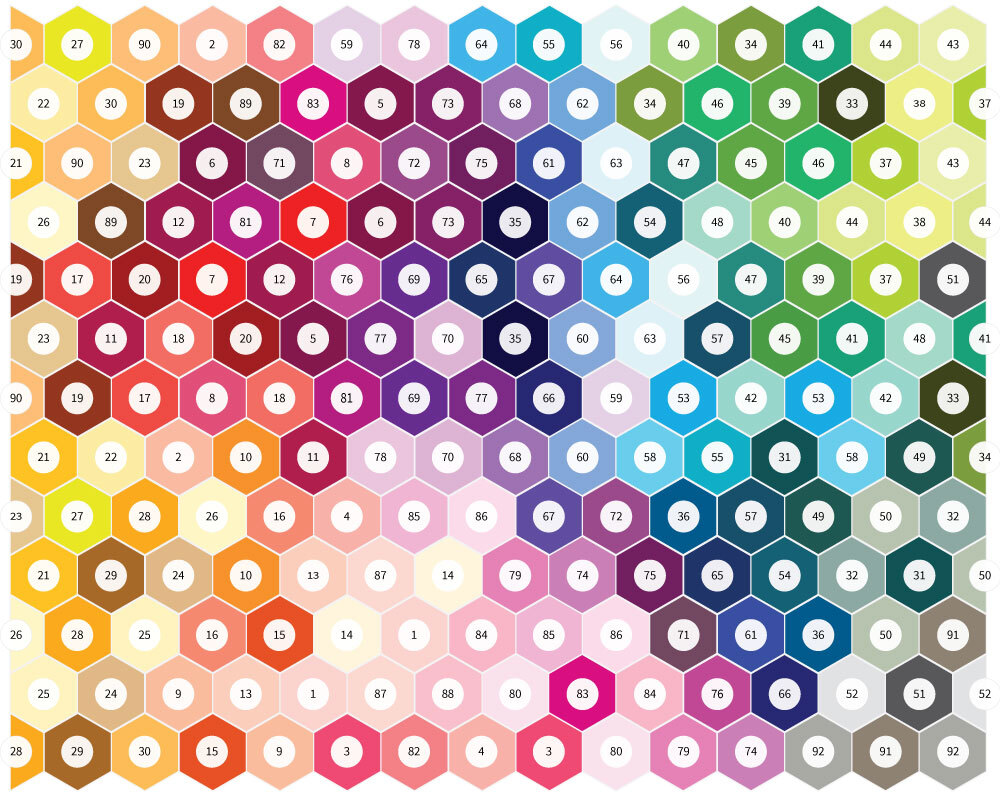
Techniques
Joining motifs
You’ll be joining the motifs as you go in the final Round. We’ll join with a flat join, which’s achieved by taking the hook out of your loop and inserting it in the back loop of your opposite motif before picking it up again. This effectively slip stitches the motifs together. After each join, you crochet a regular stitch, like you do when you’re crocheting a motif’s side.
When you join a new motif, you start with the corner. Remove your hook from your current (blue) loop. Insert it through the back loop of the second ch of the ch-sp of your opposite motif (photo 1, it’s the loop on the side closest to you). Pick up your first loop again (photo 2), and pull through the loop on hook (photo 3). You’ve now got one blue loop on your hook, and your motifs are joined in one stitch. Ch1 (that’s the other ch to form your corner), remove your hook from the blue loop, insert through the back loop of the next st on your other motif (photo 4), pick the first loop back up (photo 5) and pull through (photo 6), 1hdc in same st as your previous hdc, and that’s your corner made! I call this process of removing your hook from the loop and picking up the loop of the other stitch ‘Joining to the back loop of the opposite st’.
Continue like this across the side for the next 7 sts Joining to the back loop of the opposite st before making your hdc (photos 8-10). You now have 8 hdc made: one that’s part of your first corner, six over the side of your motif and one that’s the first hdc of your next corner. To finish up your second corner, ch1, join to back loop of first ch in the ch-sp of your other motif. That completes your side join (photo 11). If there’s another motif to join, work one ss in the join between the other two motifs and continue joining as above. If you’re not joining another motif, follow the pattern instructions.

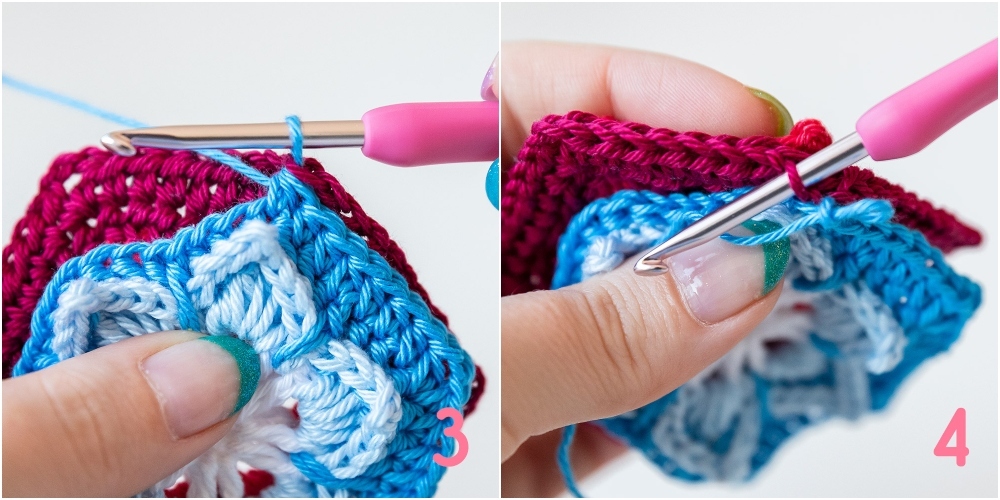
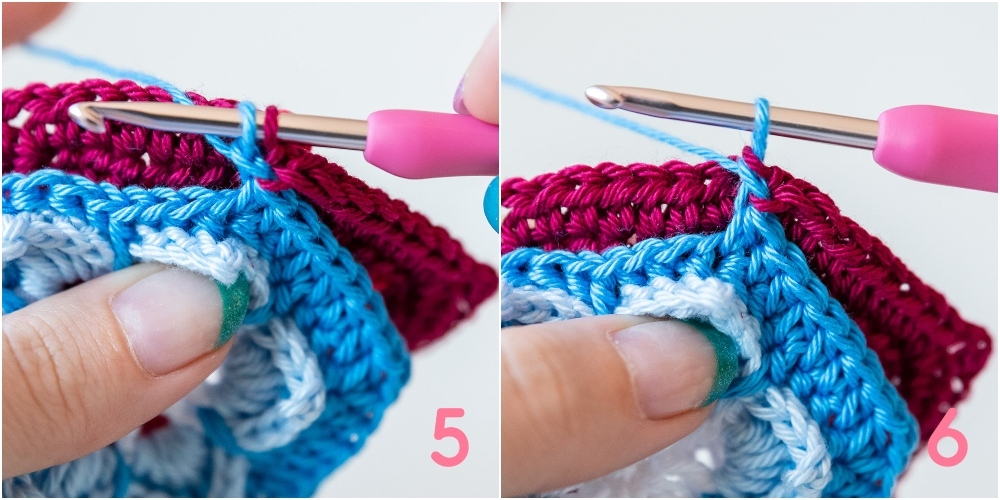
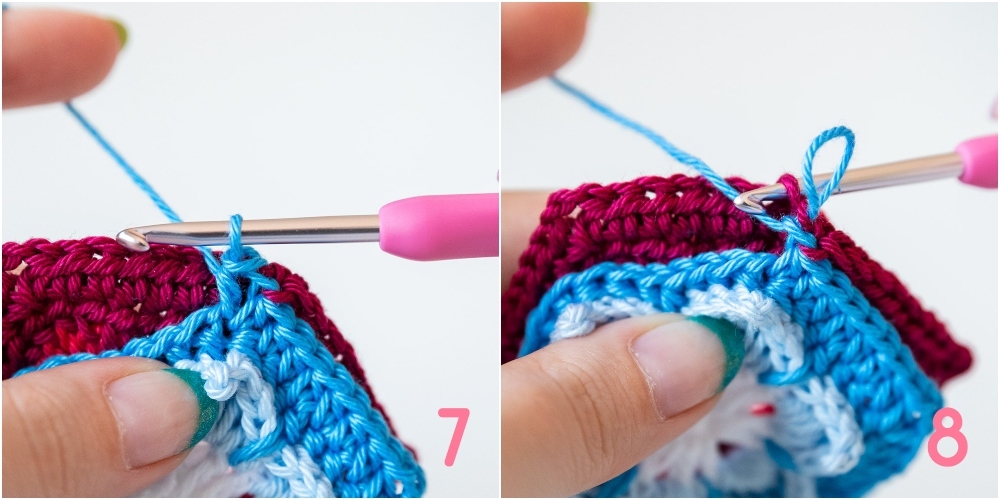
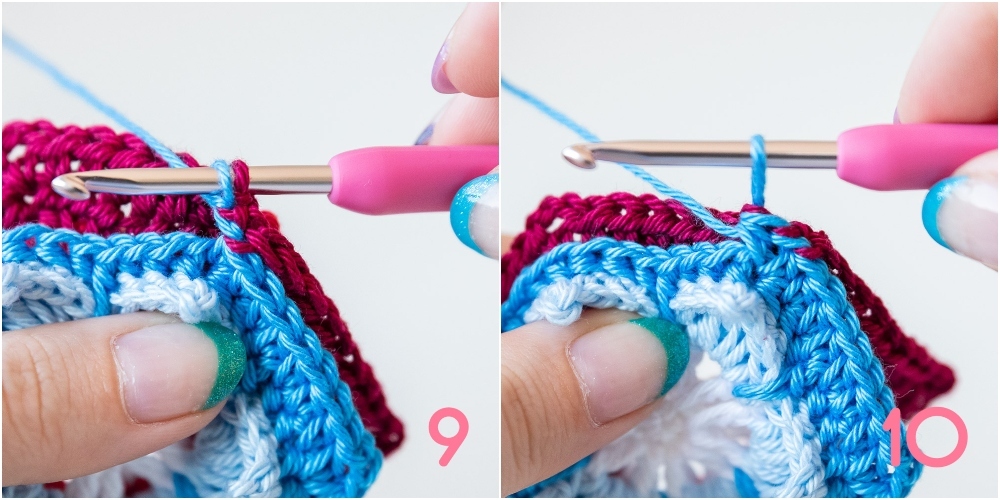
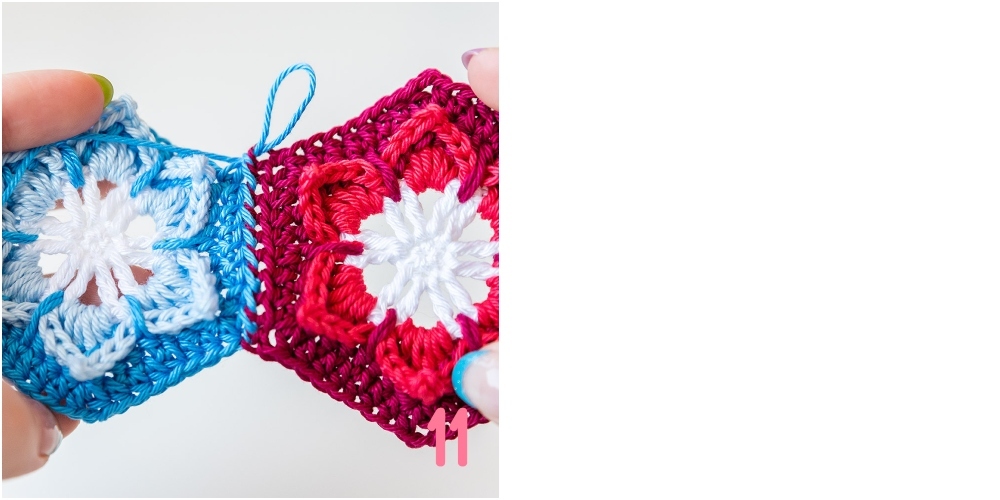
Crochet pattern
Motif (make 182)
The motifs are worked in rounds on the RS, no turning involved.
With Colour A, make a magic ring.
Round 1 (RS) 6sc in magic ring, ss in first sc, close ring by pulling thread. [6 sc]
Round 2 Ch4 (counts as first dc + ch1), 1dc in st at base of ch4, *(1dc, ch1, 1dc) in next st; repeat from * another 4 times, ss in third ch, cut yarn. [12 dc, 6 ch-sps]
Round 3 Join Colour 1 with a ss in the sp between 2 dc, ch1, 1sc in same sp, *(3dc, picot, 3dc) in next ch-1 sp, 1sc in next sp between 2 dc; repeat from * another 4 times, (3dc, picot, 3dc) in next ch-1 sp, ss in first sc, cut yarn. [36 dc, 6 picots, 6 sc]
Round 4 Join Colour 2 with a ss around the stem of st before a sc, ch2 (doesn’t count as st), 1BPhdc in same st, 1 dropped hdc in sp between 2 dc in Round 2 (dropped hdc sits over sc of previous round), *1BPhdc around each of next 6 sts skipping picot, 1 dropped hdc in sp between 2 dc of Round 2; repeat from * another 4 times, 1BPhdc around each of next 5 sts skipping picot, ss in first BPhdc, don’t cut yarn. [36 BPhdc, 6 dropped hdc]
You’ll be joining the motifs in Round 5. Work the instructions below for the first motif. Follow the instructions for Round 5 in the ‘Joining’ chapter for every other motif.
Round 5 (First motif only) Ch2 (doesn’t count as st), 1hdc in st at base of ch2, 4hdc, (1hdc, ch2, 1hdc) in next st, *6hdc, (1hdc, ch2, 1hdc) in next st; repeat from * another 4 times, 1hdc, ss in first hdc, cut yarn. [48 hdc, 6 ch-sps]
Weave in all ends. You can crochet over the ends of Round 1, 3 and 5 as you go if you don’t want to weave in all the ends separately.
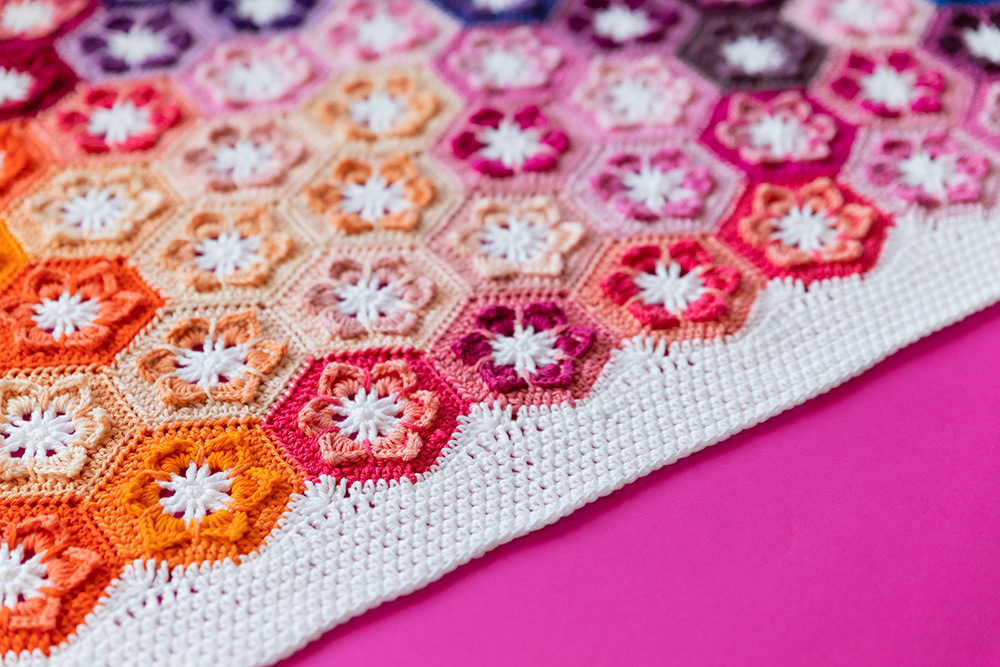
Half motif (make 13)
The half motif will be worked in rows. You will turn in the first row. All other rows are worked from the RS without turning. See Diagram 2: Half Motif for extra clarification.
With Colour A, make a magic ring.
Row 1 (WS) Ch1, 4sc in ring, don’t close ring with ss as for whole motif but turn work, pull ring tight. [4 sc]
Row 2 (RS) Ch4 (counts as first dc + ch1), 1dc in sc at base of ch4, (1dc, ch1, 1dc) 3 times, cut yarn. [8 dc, 4 ch]
Row 3 (RS) Join Colour 1 with ss in the first ch-sp, (ch3, picot, 3dc) in ch-sp, *1sc between 2 dc from previous row, (3dc, picot, 3dc) in next ch-sp; repeat from * another time, 1sc between 2 dc from previous row, (3dc, picot, 1dc) in final ch-sp, cut yarn. [20 dc, 4 picots, 3 sc]
Row 4 (RS) Join Colour 2 with a ss in first ch-sp (to the right of the picot, so it will look like you’re making a BPhdc around the ch3), ch2 (counts as first BPhdc), skip picot, 1BPhdc around each of next 3 dc’s, 1 dropped hdc in sp between 2 dc’s of Row 2 (dropped hdc sits over sc of previous row), *1BPhdc around each of next 6 sts skipping picot, 1 dropped hdc in sp between 2 dc’s of Row 2; repeat from * another time, 1BPhdc around each of next 4 sts skipping picot, cut yarn. [20 BPhdc, 3 dropped hdc]
You’ll be joining the half motifs in Row 5. Because you cut yarn between Row 4 and 5 anyway, You can find Row 5 joining instructions for the half motifs in the ‘Joining’ chapter below.
Weave in all ends.
Joining
You’ll be joining the motifs as you go in its final Round. We’ll join with a flat join. This is done as follows: remove your hook from the loop on your current motif, insert hook in the stitch on the other motif from front to back, pick up the loop again and pull through the stitch, effectively slip stitching the stitches together. After joining the stitch, you work a regular stitch like you would if you were crocheting a side.
This method gives you a flat and delicate finish. It is a little time consuming too. If you’d rather make a quick join, simply crochet the motifs together with ss’s in each motif corner and skip the picking up of stitches.
You’ll first be joining all full motifs. Once the blanket is assembled, you’ll add the half motifs. Please note that the left corners have different joining instructions than the other half motifs due to their placement.
Joining whole motifs
I joined the length of the blanket first and as such, crocheted 14 motifs together to form the first row. Then I joined the motifs from the next row one by one to the first row, and so on for all other rows.
Read the instructions below carefully. It looks complicated, but once you get the rhythm of the join it will become easier. See the photo tutorial for visual instructions.
Joining Round 5 (RS) Ch2 (doesn’t count as st), 1hdc in st at base of ch2, 4hdc, *(1hdc, ch2, 1hdc) in next st, 6hdc; repeat from * until you reach a side that needs to be joined to other motifs. 1hdc, ch1.
*Remove hook from loop, pick up back loop from second ch in corner of other motif, pick up loop from original motif, pull through. You’ve now joined to the other motif with what’s basically a ss in the back loop. Ch1, remove loop from hook, pick up back loop of the next st on the other motif (this is the first hdc), pick up loop again and pull through, 1hdc in corner-st on original motif (the st where you’ve also made your last hdc). You finished your first joined corner space.
Continue across side of motif by working (join to back loop of st on other motif, 1hdc) 7 times, join to back loop of next st on other motif, ch1, ss in join/ch, ch1, join to back loop of first hdc on next motif, 1hdc in corner-st of motif, (join to back loop of st on other motif, 1hdc) 7 times, join to back loop of next st on other motif, ch1, ss in join/ch, ch1; If you need to join another side, repeat from * to ; another time. If you’ve reached a non-joined side, 1hdc in same st as last hdc to create corner, 1hdc, ss in first hdc, cut yarn. [48 hdc, 6 ch-sps]
Joining troubleshooting
It happens occasionally that one side of the motif has more stitches than the other. Usually it means that you’ve crocheted sts in the corner space of Round 3 or 4. You can either redo the motif, or improvise a little bit in Round 5 by crocheting sts together on the short side, and working multiple sts in one st on the long side.
Joining half motifs
The half motifs are joined over their short sides to other motifs. Please note that the instructions for the left upper corner and left bottom corner half motifs differ from the general instructions. They’re specified below.
Joining Row 5 (RS) Join Colour 2 with a ss in second ch from beg-ch of previous row, ch2, ss in ch-sp of other motif, ch1, (join to back loop of st on other motif, 1hdc) 8 times, join to back loop of next st on other motif, ch1, ss in join/ch, ch1.
Pick up back loop of ch on next motif, 1hdc in same st as last hdc to create corner, (join to back loop of st on other motif, 1hdc) 7 times, join to back loop of next st on other motif, ch1, ss in join/ch, ch1.
Pick up back loop of second ch on next motif, 1hdc in same st as last hdc to create corner, (join to back loop of st on other motif, 1hdc) 7 times, join to back loop of next st on other motif, ch1, ss in join/ch, ch1, 1hdc in same st as prev hdc. Cut yarn. [26 hdc, 4 ch-2 corners]
Left upper corner half motif (colour combo 30)
Note: The final side of this motif does not have an adjacent motif.
Joining Round (RS) Join Colour A with a ss in the most right ch-sp, ch2, ss in ch-sp of other motif, join sides as for full motif. When you’ve worked the ss in the final corner, ch1, 1hdc in same st as corner hdc, 7hdc, ch1, 1hdc in final st. Cut yarn.
Left bottom corner half motif (colour combo 28)
Note: The first side of this motif does not have an adjacent motif.
Joining Round (RS) Join Colour A with a ss in the most right ch-sp, ch2, 7hdc, 1hdc in final st on side, ch1, ss in other ch-sp, continue joining as for other half motifs. Cut yarn.
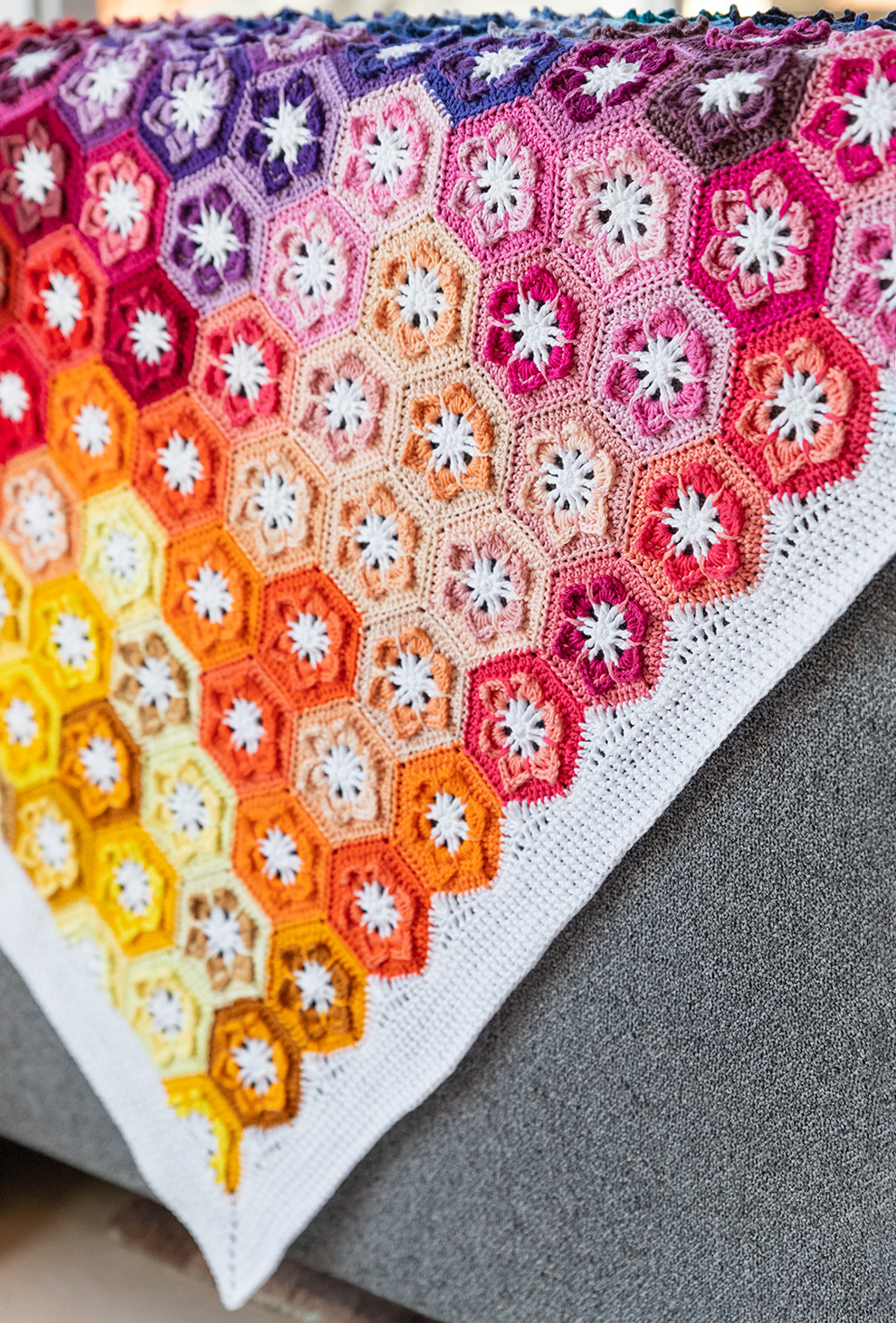
Edge
The first couple of rounds are a mixture of different stitches with different heights. This is so we can fill up the gaps on the long sides of the blanket. It might look complicated, but once you get into the rhythm of the stitches it will make sense. Have a look at Diagram 3: Edge Rounds 1-4 for some visual help.
Round 1 (RS) Join Colour A with a ss in the left upper corner (orange/brown half motif), ch2 (counts as first hdc), *14hdc divided evenly over long side motif, 8hdc in next motif, 1hdc in last ch-sp of motif; repeat from * another 5 times, 14hdc divided evenly over long side motif, 1hdc in last ch-sp, ch2, rotate blanket 90 degrees.
1sc in corner-sp, *2sc, 3hdc, 1dc, dc5tog in next 2 sts, join and next 2 sts on other motif while skipping the ch -sp’s, 1dc, 3hdc, 2sc, 1sc in ch-sp; repeat from * another 13 times, 2sc, 3hdc, 1dc, dc2tog in last 2 sts, 1dc in corner-sp, ch2, rotate blanket 90 degrees.
1hdc in corner-sp, *8hdc in next motif, 1hdc in last ch-sp of motif; 14hdc divided evenly over long side motif; repeat from * another 5 times, 8hdc in next motif, 1hdc in corner-sp, ch2, rotate blanket 90 degrees.
1dc in ch-sp, dc2tog in first 2 sts, 1dc, 3hdc, 2sc, 1sc in ch-sp, *2sc, 3hdc, 1dc, dc5tog in next 2 sts, join and next 2 sts on other motif while skipping the ch-sp’s, 1dc, 3hdc, 2sc, 1sc in ch-sp; repeat from * another 13 times, ch2, join with ss in beg-ch2, cut yarn. [First short side 154 sts, long sides 205 sts, second short side 148 sts]
There’s a difference of 6 sts here between both short sides, because the alignment of long side and top sides of half motifs differ on both sides. This will not have an effect on the end result.
Round 2 (RS) Join Colour A with a ss in the left upper corner, ch2 (counts as first hdc), 1hdc in each st to corner-sp, 1hdc in corner-sp, rotate blanket 90 degrees.
1sc in corner-sp, *sc2tog, 3hdc, 2dc, dc2tog in dc5tog and next st, 2dc, 3hdc; repeat from * another 13 times, sc2tog, 3hdc, 2dc, dc2tog, 1dc in ch-sp, ch2, rotate blanket 90 degrees.
1hdc in corner-sp, 1hdc in each st to end, 1hdc in corner-sp, ch2, rotate blanket 90 degrees.
1dc in corner-sp, dc3tog, 2dc, 3hdc, *sc2tog, 3hdc, 2dc, dc2tog in dc5tog and next st, 2dc, 3hdc; repeat from * another 13 times, 1sc in last st, 1sc in corner-sp, ch2, join to first st. [First short side 156 sts, long sides 177 sts, second short side 150 sts]
Round 3 (RS) Join Colour A with a ss in the left upper corner, ch2 (counts as first hdc), *1hdc in each st to end, (1hdc, ch2 1hdc) in ch-sp; repeat from * another 2 times, 1hdc in each st to end, 1hdc in ch-sp, ch2, join to first st. cut yarn. [First short side 158 sts, long sides 178 sts, second short side 152 sts]
The edge should almost lay completely flat at this point. If it instead waves, it means that you have more sts in the edge than ‘space’ available. To counter this, check where your blanket waves (this is often on the long sides, above the ch-sps of motifs), and mark with stitch markers if necessary on Round 2. Next, rip out Round 3 and decrease by crocheting either a hdc2tog or dc2tog on the indicated spaces. If need be, work extra decreases in the upcoming rounds.
Rounds 4-8 Join Colour A with a ss in the left upper corner, ch2 (counts as first hdc), *1hdc in each st to corner-sp, (2hdc, ch2, 1hdc) in corner-sp; repeat from * another 2 times, 1hdc in each st to corner-sp, 2hdc, ch2, join with ss in first st, cut yarn. [First short side 173 sts, long sides 193 sts, second short side 167 sts]
As you can see I’m working 2hdc on one side of the corner-sp, and only 1hdc on the other. Because we’re working in rounds and the stitches are slightly slanted, this would eventually cause your corners to become rounded because of excessive pulling on one side of the corner. By making 2hdc in the corner-sp at the end of each side you’ll offset this. However, if you feel that you only need 1hdc feel free to adjust.
Weave in all ends and block the blanket to size.
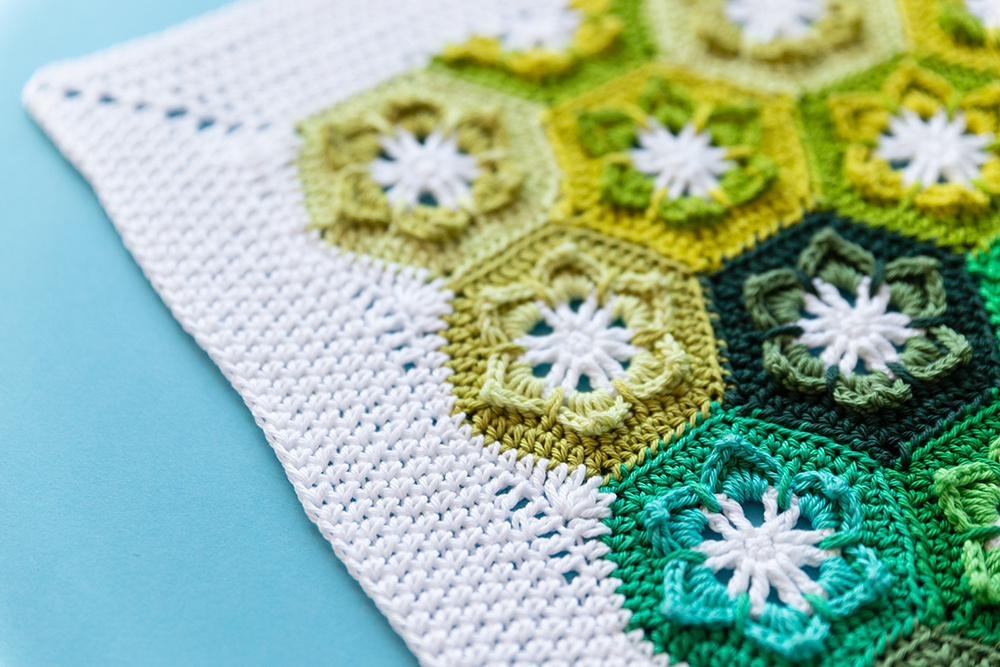
Adjusting the size of the blanket
You can adjust the size of the blanket by adding more motifs. I would recommend adding (or removing) in multiples of two: adding two motifs to each row (i.e. 16 motifs per row) or adding two rows to the blanket (i.e. 15 rows). This way, you will not have to adjust any instructions for the edge other than working more or less repeats from the pattern as written.
Two motifs add 15cm (5.5in) to the length of the blanket, and two rows add 15cm (5.9in) to the height of the blanket.
Diagram
Diagram 1: Full Motif

Diagram 2: Half Motif
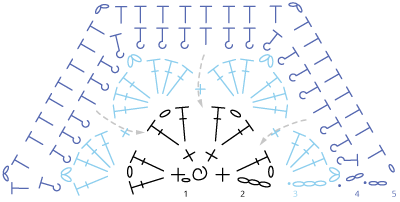
Diagram 3: Edge Rounds

Key (US terms)
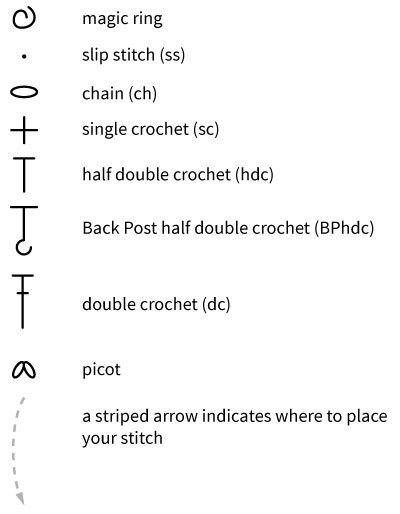





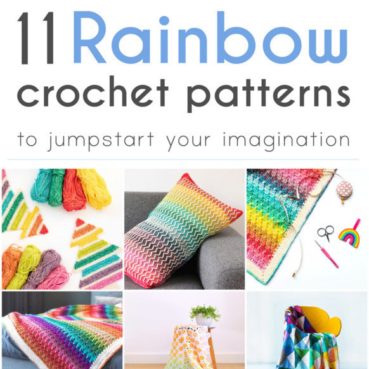
Comments